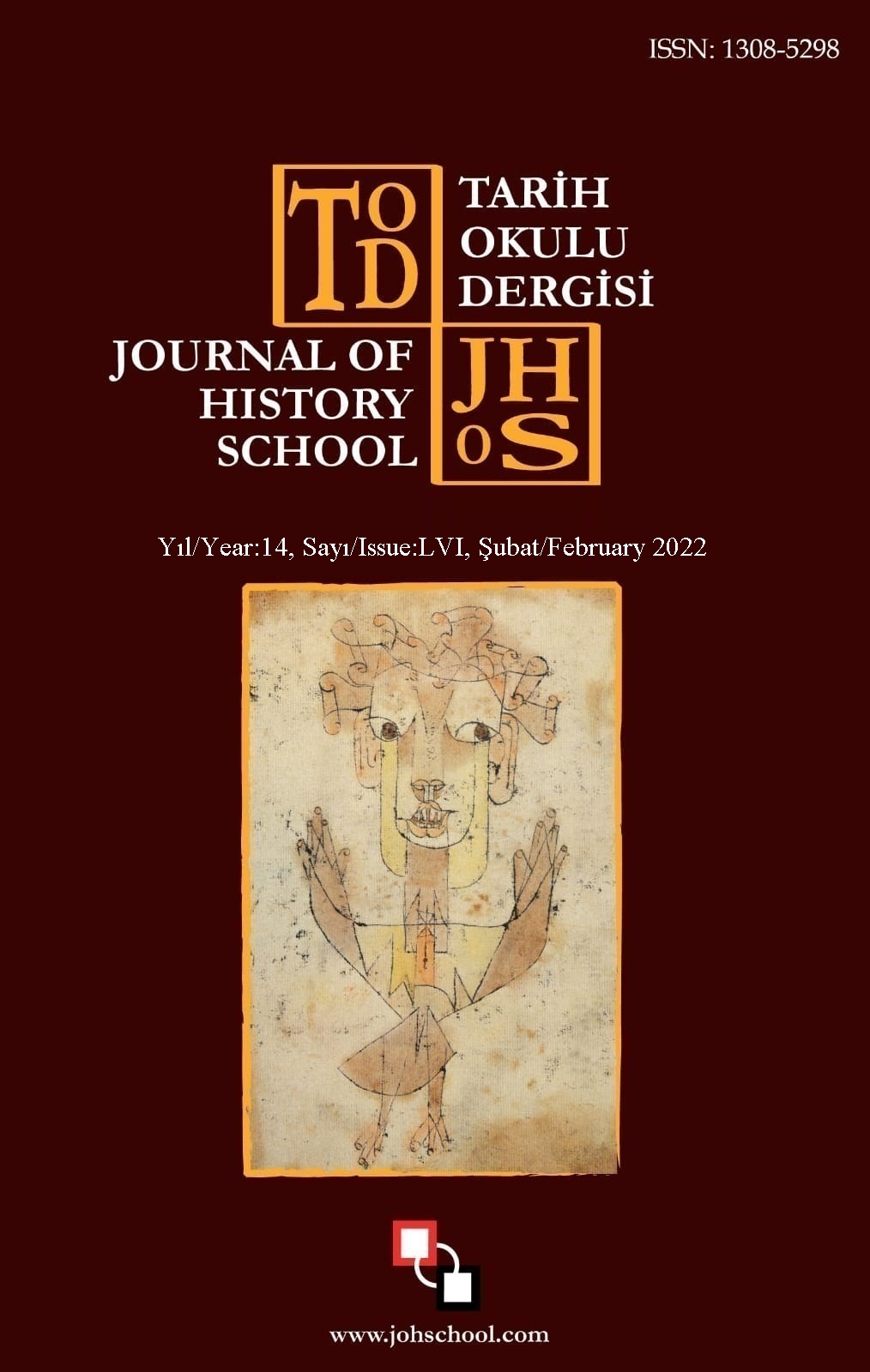Author :
Abstract
18 Eylül 96 tarihinde gerçekleşen Titus Flavius Domitian suikastı M.S.69 yılından itibaren Roma İmparatorluğunu yöneten Flavian hanedanının sonunu getirmiştir. Suikast, küçük bir gruptan oluşan saray görevlileri tarafından gerçekleştirilmiştir. Fakat bu çalışma komplocuların, imparatoru sürekli olarak elimine etmeye çalışan muhalif figürlerle ilişkisini ortaya koymaya çalışmaktadır. Suetonius, Genç Pliny, ve Cassius Dio gibi yazılarında klasik tarihçiler suikastı, senato tarafından nefret edilen imparatoru daha fazla kötülemek için kullanmıştır. Domitian’ı rehabilite etme çabalarında bulunan yirminci yüzyıl tarihçileri suikaste yönelik yeni hipotezler ve açıklamalar eklemiştir. Bu çalışma, Domitian’ın ölümüne yönelik iddiaları göstermekte, görüşlerin doğruluğunu, komplocuları, motivasyonu araştırmakta ve bir yaklaşım önerme amacını taşımaktadır. Bu doğrultuda, Domitian’ın dönemindeki komploları ve bunların cinayet ile ilgisini göstermektedir. Son olarak da suikastin sonrasında yaşanan olayları inceleyerek komplocuların imparatoru öldürerek amaçlarına ulaşıp ulaşmadığını incelemektedir.
Keywords
Abstract
The assassination of Titus Flavius Domitian on 18 September 96 brought the end of Flavian dynasty, which had been ruling the Roman Empire since AD 69. The assassination was carried by a small group of court officials. However, this paper tries to indicate that the conspirators were related with oppositional figures, who constantly tried to eliminate the emperor. Classical historians Suetonius, Pliny the Younger, and Cassius Dio in their accounts used the assassination to further slander the emperor, hated by the senate. Twentieth century historians, who engaged in endeavors of rehabilitation of Domitian, added new hypothesis and explanations to his assassination. This paper intends to demonstrate the claims on Domitian’s death, to investigate the accuracy of the views on the assassination, conspirators, motives, and to offer a fresh perspective. For this purpose, it presents the conspiracies under Domitian’s and their connections with the murder. Finally, it examines the aftermath of the assassination to evaluate whether the conspirators reached their aim with the murder of the emperor.
Keywords
- Applebaum, S. (1974). Domitian’s assassination: The Jewish aspect. Scripta Classica Israelica, 116–123.
- Barbara L. (2002). Corbulo’s daughter. Greek & Rome, 49(2), 199–211
- Berriman, A., Todd, M., & Todd, M. (2001). A very roman coup: The Hidden war of imperial succession, AD 96-98. Historia: Zeitschrift Für Alte Geschichte, 50(2), 312–331.
- Birley, A.R. (1999). Septimius Severus The African Emperor. Routledge.
- Bonforte, J. (1955). The Philosophy of Epictetus. Philosophical Library.
- Cassius Dio (1955). Roman History, Volume VIII, Books LXI-LXX (Earnest Cray, transl.). William Heinemann Ltd. and G. P. Putnam’s Sons.
- De Caesaribus. (1994). (H. W. Bird, transl.). Liverpool University Press.
- Ehrhardt, C.T.H.R. (1987). Nerva’s background. Liverpool Classical Monthly, 12, 18–20.
- Eusebius. (1953). Ecclesiastical History Books 1-5 (Ron J. Deferrari, transl.). The Catholic University of America Press.
- Eutropius. (2019). Complete Works of Eutropius (John Selby Watson, transl.). Delphi Classics.
- Evans, J.K. (1974). Senatorial History and The Principate of Domitian. Unpublished doctoral thesis, McMaster University Graduate Studies.
- Everitt, A. (2010). Hadrian and the Triumph of Rome. Random House Trade Paperbacks.
- Fraser, T. E. (2015). Domitia Longina: An Underestimated Augusta (c.53-126- 8). Ancient Society, 45, 205–266.
- Frontinus. (2015). Complete Works of Frontinus. Delphi Ancient Classics.
- Heemstra, M. (2020). The Fiscus Judaicus and the Parting of the Ways. Mohr Siebeck Verlag.
- Herodian. (2020). Complete Works of Herodian (Edward C. Echols, transl.).
- Jones, B. (1974). Senatorial influence in the revolt of Saturninus. Latomus, 529– 535.
- Jones, B. (1992). The Emperor Domitian. Routledge.
- Josephus. (2020). Complete Works of Josephus (William Whiston, transl.) Delphi Classics.
- Kleijn, G. D. (2009). C. Licinius Mucianus, Leader in time of crisis. Historia: Zeitschrift Für Alte Geschichte, 58(3), 311–324.
- Levick, B. (1999). Tiberius The Politician. Routledge.
- Malloch, S.J.V. (2015). Frontinus and Domitian: The Politics of the Strategemata. Chiron, 45, 77–100.
- Martial. (1947). Martial: Epigrams I, Books I-VII (Walter C. A. Kerr, transl.). William Heinemann and G. P. Putnam’s Sons.
- Pettinger, A. (2012). The Republic in Danger Drusus Libo and the Succession of Tiberius. Oxford University Press.
- Pleket, H. W. (1961). Domitian, the Senate and the Provinces. Mnemosyne, 14(4), 296–315.
- Pliny the Younger. (1969). Panegyricus. English & Latin. Harvard University Press.
- Pliny the Younger. (2006). Pliny the Younger Complete Letters (P.G.Walsh, transl.). Oxford University Press.
- Procopius. (2010). The History of Procopius (Richard Atweter, transl.) Forgotten Books.
- Rogers, R. S. (1960). A group of Domitianic treason-trials. Classical Philology, 55(1), 19–23.
- Saleh, J. H. (2019). Statistical reliability analysis for a most dangerous occupation: Roman Emperor. Palgrave Communications, 1–7.
- Schmitz, M. (2019). Roman Conquests: The Danube Frontier. Pen & Sword Books Limited.
- Smith, M. F. (1996). An Epicurean Priest from Apamea in Syria. Zeitschrift Für Papyrologie Und Epigraphik, 112, 120–130.
- Southern, P. (1997). Domitian the Tragic Tyrant. Routledge.
- Spinelli, T., & Gregori, G. L. (2019). (Un)-Damning Subplots: The Principate of Domitian between literary sources and Fresh material evidence. Illinois Classical Studies, 44(2), 242–267.
- Suetonius. (1959). The Lives of the Caesars Volume 1 (John C. Rolfe, transl.). William Heinemann Ltd. and Harvard University Press.
- Suetonius. (1959). The Lives of the Caesars. Volume II (John C. Rolfe, transl.).
- Syme, R. (1978). Antonius Saturninus. The Journal of Roman Studies, 68,12–21.
- Syme, R. (1958). Tacitus Volume I. Clarendon Press.
- Waters, K. H. (1964). The character of Domitian. Phoenix, 18(1), 49–77.
- Waters, K.H. (1969). Traianus Domitiani Continuator. The American Journal of Philology, 90(4), 385–405. EXTENDED ABSTRACT





